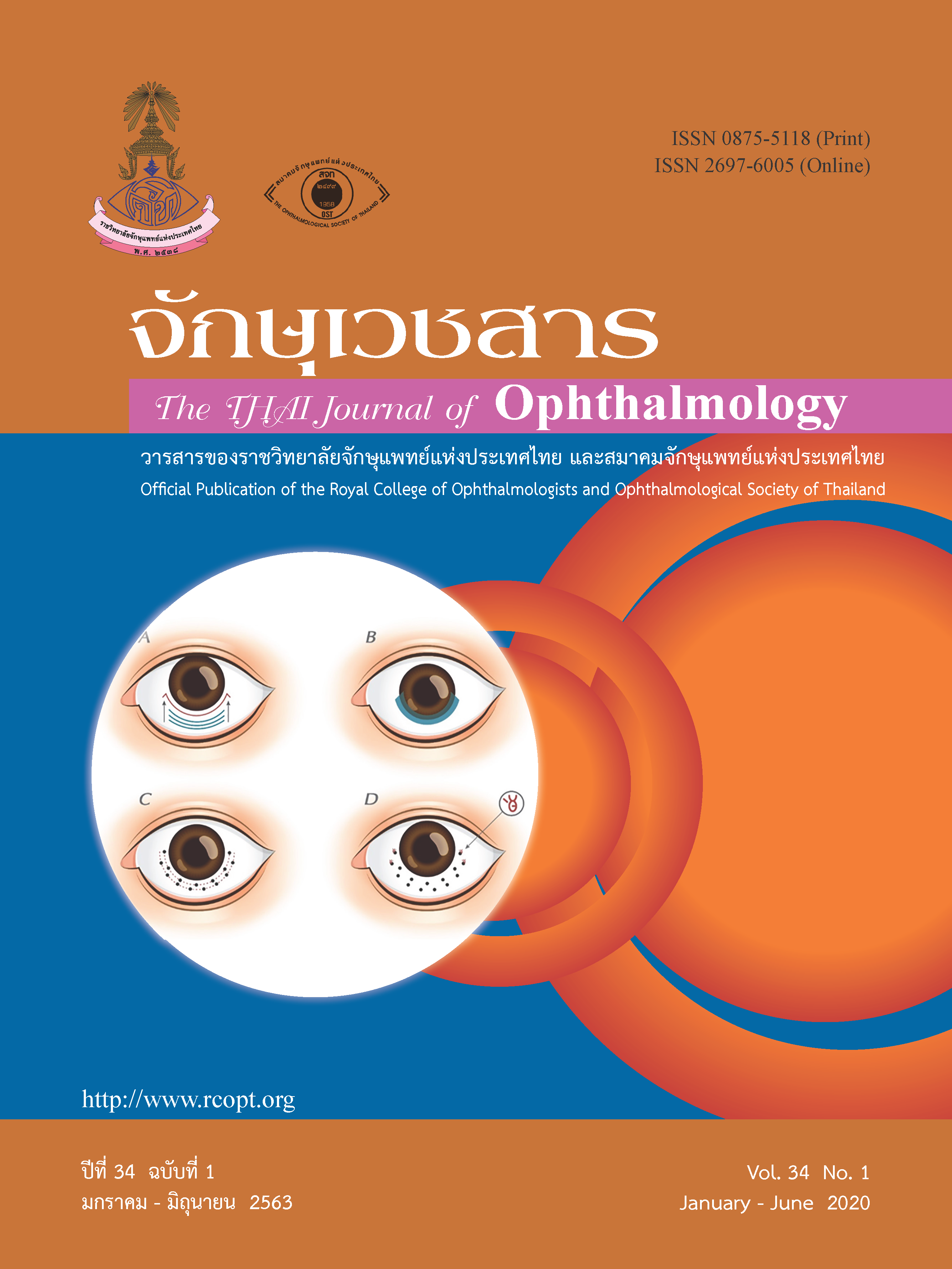Outcomes of Flanged Intrascleral Intraocular Lens Fixation with Single Needle Techniques in Traumatic Eyes: An Interventional Case Series
Keywords:
Intraocular lens, traumatic eye injury, flanged intrascleral intraocular lens fixation, scleral intraocular lens fixationAbstract
Purpose: To propose and determine the clinical outcomes and safety of flanged intrascleral intraocular lens (IOL) fixation with a new single needle technique in traumatic eye injury.
Methods: Eyes with traumatic cataract with inadequate posterior capsule support, aphakia, or lens dislocation from traumatic eye injury were operated using flanged intrascleral IOL fixation with single needle techniques. Preoperative demographic data, best-corrected visual acuity (BCVA), refraction and complications were collected. Sub-analysis to compare fixating locations between 12-6 and 3-9 o’clock was performed.
Results: Ten eyes from 10 patients were reviewed. After surgery, BCVA improved to 0.28 logMAR,P < 0.001. Mean post-operative final manifest refraction (Spherical Equivalent) at the third month of follow-up was -0.15 diopters (D). The mean difference between the target refraction and final manifest refraction was 0.05 D. For the sub-analysis, there was a significant difference in the direction shift from the target refraction between the 2 locations. A minus shift from the target refraction occurred in location 3-9 o’clock, whereas a plus shift occurred mostly in location 12-6 o’clock (P=0.02). IOL fixed at location 3-9 o’clock had a lesser estimated refractive error (75% within 0.5 D) compared to that at location 12-6 o’clock (16.7%). Two eyes with vitreous hemorrhage were observed after surgery.
Conclusions: Flanged intrascleral IOL fixation with single needle technique resulted in good visual outcome and is a safe implantation technique in traumatic eye injury. Our data suggested that IOL fixed at location 3-9 o’clock tended to have a minus shift from the target refraction in contrast to IOL fixed at location 12-6 o’clock, which showed a plus shift.
References
Negrel AD, Thylefors B. The global impact of eye injuries. Ophthalmic Epidemiol. 1998;5(3):143-69.
Karlson TA, Klein BE. The incidence of acute hospital-treated eye injuries. Arch Ophthalmol. 1986;104(10):1473-6.
Klopfer J, Tielsch JM, Vitale S, See LC, Canner JK. Ocular trauma in the United States. Eye injuries resulting in hospitalization, 1984 through 1987. Arch Ophthalmol. 1992;110(6):838-42.
Fong LP. Eye injuries in Victoria, Australia. Med J Aust. 1995;162(2):64-8.
Wong TY, Tielsch JM. A population-based study on the incidence of severe ocular trauma in Singapore. Am J Ophthalmol. 1999;128(3):345-51.
Cillino S, Casuccio A, Di Pace F, Pillitteri F, Cillino G. A five-year retrospective study of the epidemiological characteristics and visual outcomes of patients hospitalized for ocular trauma in a Mediterranean area. BMC Ophthalmol. 2008;8:6.
Choovuthayakorn J, Worakriangkrai V, Patikulsila D, Watanachai N, Kunavisarut P, Chaikitmongkol V, et al. Epidemiology of Eye Injuries Resulting in Hospitalization, a Referral Hospital-Based Study. Clin Ophthalmol. 2020;14:1-6.
Yamane S, Sato S, Maruyama-Inoue M, Kadonosono K. Flanged Intrascleral Intraocular Lens Fixation with Double-Needle Technique. Ophthalmology. 2017;124(8):1136-42.
Downing JE. Ten-year follow up comparing anterior and posterior chamber intraocular lens implants. Ophthalmic Surg. 1992;23(5):308-15.
Hyun DW, Lee TG, Cho SW. Unilateral scleral fixation of posterior chamber intraocular lenses in pediatric complicated traumatic cataracts. Korean J Ophthalmol. 2009;23(3):148-52.
McCluskey P, Harrisberg B. Long-term results using scleral-fixated posterior chamber intraocular lenses. J Cataract Refract Surg. 1994;20(1):34-9.
Agarwal A, Kumar DA, Jacob S, Baid C, Agarwal A, Srinivasan S. Fibrin glue-assisted sutureless posterior chamber intraocular lens implantation in eyes with deficient posterior capsules. J Cataract Refract Surg. 2008;34(9):1433-8.
Azar DT, Wiley WF. Double-knot transscleral suture fixation technique for displaced intraocular lenses. Am J Ophthalmol. 1999;128(5):644-6.
Drolsum L. Long-term follow-up of secondary flexible, open-loop, anterior chamber intraocular lenses. J Cataract Refract Surg. 2003;29(3):498-503.
Biro Z. Results and complications of secondary intraocular lens implantation. J Cataract Refract Surg. 1993;19(1):64-7.
Vote BJ, Tranos P, Bunce C, Charteris DG, Da Cruz L. Long-term outcome of combined pars plana vitrectomy and scleral fixated sutured posterior chamber intraocular lens implantation. Am J Ophthalmol. 2006;141(2):308-12.
Saleh M, Heitz A, Bourcier T, Speeg C, Delbosc B, Montard M, et al. Sutureless intrascleral intraocular lens implantation after ocular trauma. J Cataract Refract Surg. 2013;39(1):81-6.
Yang CS, Chao YJ. Long-term outcome of combined vitrectomy and transscleral suture fixation of posterior chamber intraocular lenses in the management of posteriorly dislocated lenses. J Chin Med Assoc. 2016;79(8):450-5.
Dannenberg AL, Parver LM, Fowler CJ. Penetrating eye injuries related to assault. The National Eye Trauma System Registry. Arch Ophthalmol. 1992;110(6):849-52.
Rogers G, Mustak H, Hann M, Steven D, Cook C. Sutured posterior chamber intraocular lenses for traumatic cataract in Africa. J Cataract Refract Surg. 2014;40(7):1097-101.
Ahn JK, Yu HG, Chung H, Wee WR, Lee JH. Transscleral fixation of a foldable intraocular lens in aphakic vitrectomized eyes. J Cataract Refract Surg. 2003;29(12):2390-6.
Bourke RD, Gray PJ, Rosen PH, Cooling RJ. Retinal detachment complicating scleral-sutured posterior chamber intraocular lens surgery. Eye (Lond).1996;10 (Pt 4):501-8.
Downloads
Published
Issue
Section
License
The Thai Journal of Ophthalmology (TJO) is a peer-reviewed, scientific journal published biannually for the Royal College of Ophthalmologists of Thailand. The objectives of the journal is to provide up to date scientific knowledge in the field of ophthalmology, provide ophthalmologists with continuing education, promote cooperation, and sharing of opinion among readers.
The copyright of the published article belongs to the Thai Journal of Ophthalmology. However the content, ideas and the opinions in the article are from the author(s). The editorial board does not have to agree with the authors’ ideas and opinions.
The authors or readers may contact the editorial board via email at admin@rcopt.org.


